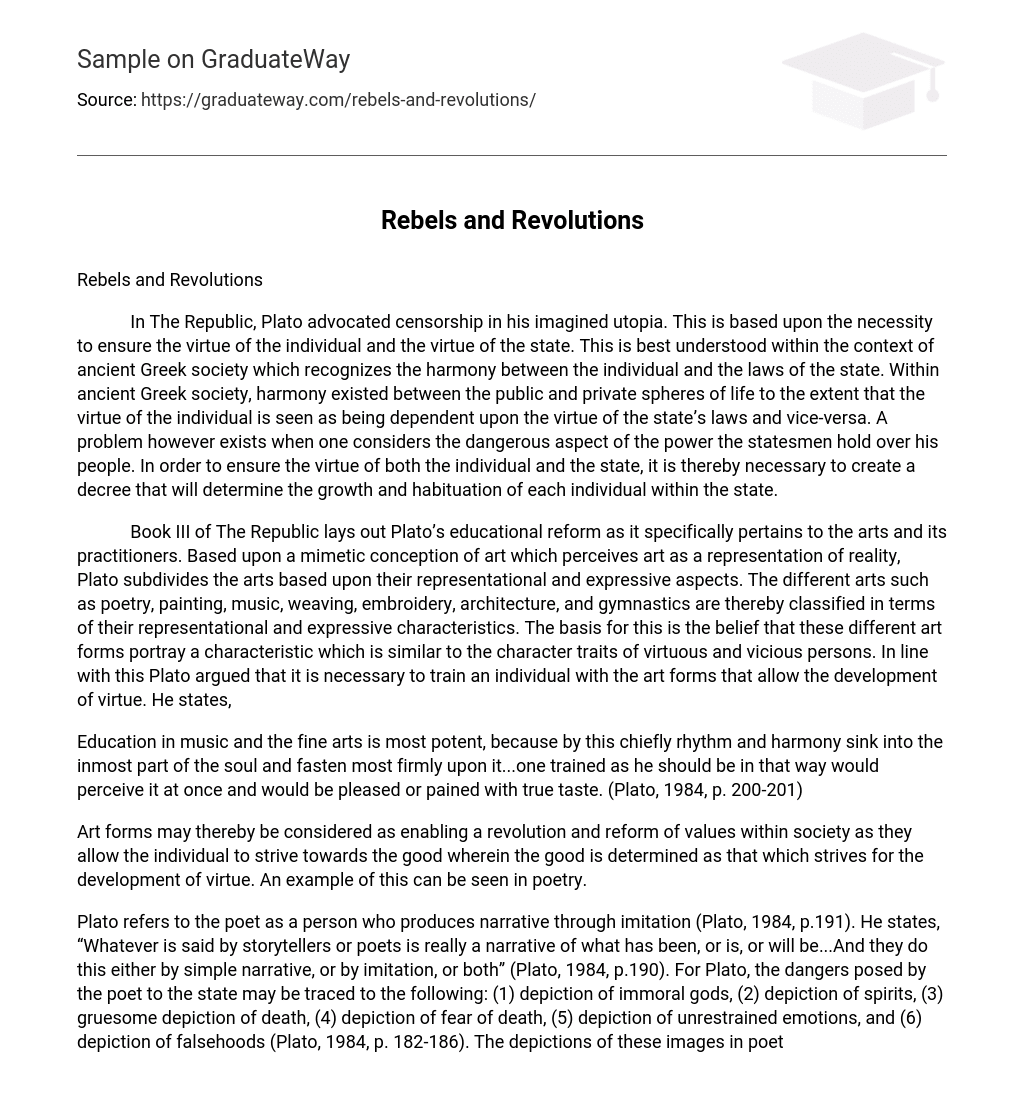In The Republic, Plato advocated censorship in his imagined utopia. This is based upon the necessity to ensure the virtue of the individual and the virtue of the state. This is best understood within the context of ancient Greek society which recognizes the harmony between the individual and the laws of the state. Within ancient Greek society, harmony existed between the public and private spheres of life to the extent that the virtue of the individual is seen as being dependent upon the virtue of the state’s laws and vice-versa. A problem however exists when one considers the dangerous aspect of the power the statesmen hold over his people. In order to ensure the virtue of both the individual and the state, it is thereby necessary to create a decree that will determine the growth and habituation of each individual within the state.
Book III of The Republic lays out Plato’s educational reform as it specifically pertains to the arts and its practitioners. Based upon a mimetic conception of art which perceives art as a representation of reality, Plato subdivides the arts based upon their representational and expressive aspects. The different arts such as poetry, painting, music, weaving, embroidery, architecture, and gymnastics are thereby classified in terms of their representational and expressive characteristics. The basis for this is the belief that these different art forms portray a characteristic which is similar to the character traits of virtuous and vicious persons. In line with this Plato argued that it is necessary to train an individual with the art forms that allow the development of virtue. He states,
Education in music and the fine arts is most potent, because by this chiefly rhythm and harmony sink into the inmost part of the soul and fasten most firmly upon it…one trained as he should be in that way would perceive it at once and would be pleased or pained with true taste. (Plato, 1984, p. 200-201)
Art forms may thereby be considered as enabling a revolution and reform of values within society as they allow the individual to strive towards the good wherein the good is determined as that which strives for the development of virtue. An example of this can be seen in poetry.
Plato refers to the poet as a person who produces narrative through imitation (Plato, 1984, p.191). He states, “Whatever is said by storytellers or poets is really a narrative of what has been, or is, or will be…And they do this either by simple narrative, or by imitation, or both” (Plato, 1984, p.190). For Plato, the dangers posed by the poet to the state may be traced to the following: (1) depiction of immoral gods, (2) depiction of spirits, (3) gruesome depiction of death, (4) depiction of fear of death, (5) depiction of unrestrained emotions, and (6) depiction of falsehoods (Plato, 1984, p. 182-186). The depictions of these images in poetry, according to Plato, may lead the individual [specifically the guardian of the state] to fail in the practice of his duties towards the state. Access to such images may lead the individual to imitate such characteristics thereby obstructing his path towards a virtuous life. In the case of depicting the utterance of falsehoods, he claims that it will lead individuals to demean the value of truth. Such images are thereby censored in Plato’s ideal state.
This does not necessarily mean that Plato does not recognize the capacity of those poets capable of representing the good in its various forms. He states,
Suppose then there was a man so clever that he could take all kinds of shapes and imitate anything and everything…We should prostrate ourselves before him as one sacred and wonderful and delightful, but we should say that we cannot admit such a man into our city; the law forbids and there is no place for him. (Plato, 1984, p.195-196).
No place exists for such a man within Plato’s ideal state since such a man will hinder in the development of its citizens. By employing the “more austere and less pleasing poet”, one is ensured of the development of the virtue of the citizens since such poets would merely follow the narratives which are allowed by the law. Plato’s argument for all art forms to follow “the pure style imitating the good” is thereby based upon the premise that it is only through the proliferation of the images of the good in all vestiges of the society and in the individual’s initial education that it will be possible for the individual to be habituated in the practice of the good life.
Plato’s approach on the citizens’ education on art forms may be seen as taking the form of reform, transformation, and revolution. By initially reforming [through the practice of censorship] the education of the individual, he expects a transformation of the individuals within society and later on society as a whole thereby enabling a revolution of values within the state. It is important to note that this approach conceives of art as being political in nature. This can be understood within the Greek concept of art.
The Greeks conceives of art as techne which literally means knowledge of how one fabricates something (Gadamer, 2000, p. 74). Politics is itself considered as a techne, knowledge of how one fabricates the city-state. By determining the individual’s education regarding art forms in the initial part of his life and by enabling such an education to be a way of life and hence a tradition, Plato strengthened the foundation of the city-state by strengthening the morality of its members. Undergoing the art education which Plato prescribed in the Third Book of The Republic ensured that the individuals within the new city-state [the ideal republic] would be virtuous individuals who are in possession of both temperance and bravery.
References
Gadamer, H. (2000). The Beginning of Philosophy. New York: Continuum.
Plato. (1984). The Republic. Great Dialogues of Plato. Trans. W.H.D. Rouse. New York: Penguin.





